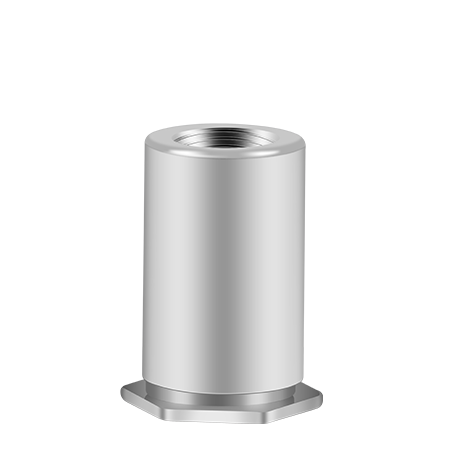In manufacturing and construction industries, fasteners play a pivotal role in joining components and structures. Among the various types of fasteners, nuts are essential for creating secure and reliable connections. In recent years, Blind Clinch Nut has emerged as an alternative to traditional nuts, offering unique advantages in certain applications. This article provides a comparative analysis of Blind Clinch Nut and traditional nut, focusing on their installation, usage, and performance, as well as their respective advantages and limitations.

1.Installation:
Blind Clinch Nut is designed for installation in thin sheet materials where access to the backside of the workpiece is limited. The installation process involves using a press or similar equipment to deform the nut body, creating a permanent, strong, and flush-mounted threaded insert. This method eliminates the need for additional hardware on the backside of the workpiece, simplifying assembly and reducing overall production costs.
Traditional Nut:
Traditional nuts require access to both sides of the workpiece for installation. They are typically secured using bolts or screws, which pass through the workpiece and thread into the nut. This installation method can be time-consuming, especially in applications where the backside of the workpiece is not easily accessible. Additionally, traditional nuts may require washers or lock washers to prevent loosening over time, adding complexity to the assembly process.
2.Usage:
Blind Clinch Nut:
Blind Clinch Nut is commonly used in industries such as automotive, aerospace, electronics, and consumer goods manufacturing. Its ability to provide strong and reliable threads in thin sheet materials makes it ideal for applications where space and weight are critical factors. Additionally, Blind Clinch Nut offers enhanced resistance to vibration and torque, making it suitable for high-stress environments.
Traditional Nut:
Traditional nuts are ubiquitous and find applications in a wide range of industries and products. They are versatile and available in various materials, sizes, and thread types to suit different requirements. Traditional nuts are often used in applications where accessibility is not a constraint, and their installation can be easily facilitated using common tools such as wrenches or sockets.
3.Performance:
Blind Clinch Nut:
Blind Clinch Nut offers several performance advantages, including:
Enhanced resistance to pull-out and push-through forces due to its secure deformation into the workpiece.
Reduced risk of loosening over time, even in high-vibration environments.
Improved aesthetics with flush-mounted installation, enhancing the overall appearance of the assembly.
Compatibility with automated assembly processes, leading to increased efficiency and productivity.
Traditional Nut:
Traditional nuts also offer reliable performance characteristics, such as:
Wide availability and compatibility with standard fastening hardware.
Ability to withstand high loads and pressures in various applications.
Familiarity and ease of use, requiring minimal training for installation and maintenance.
Cost-effectiveness, especially for low-volume production or applications where specialized fasteners are not required.
4.Advantages and Limitations:
Blind Clinch Nut:
Advantages:
Ideal for applications with limited access or thin sheet materials.
Enhanced resistance to vibration and torque.
Streamlined assembly process and reduced hardware requirements.
Suitable for automated production environments.
Limitations:
Initial tooling and equipment investment may be required for installation.
Limited to specific material thicknesses and configurations.
May not be suitable for high-temperature or corrosive environments without appropriate coatings or materials.
Traditional Nut:
Advantages:
Versatile and widely available.
Familiar installation process requiring minimal training.
Cost-effective for standard applications and materials.
Compatible with a wide range of fastening hardware.
Limitations:
Requires access to both sides of the workpiece for installation.
Increased risk of loosening over time, especially in high-vibration environments.
Additional hardware such as washers may be necessary to prevent loosening.
In conclusion, both Blind Clinch Nut and traditional nut offer unique advantages and limitations in terms of installation, usage, and performance. The choice between the two depends on factors such as accessibility, material thickness, vibration resistance, and production requirements. While Blind Clinch Nut provides a solution for applications with limited access and thin sheet materials, traditional nut remains a versatile and cost-effective option for a wide range of fastening needs. Ultimately, careful consideration of the specific application requirements is essential to determine the most suitable fastening solution.